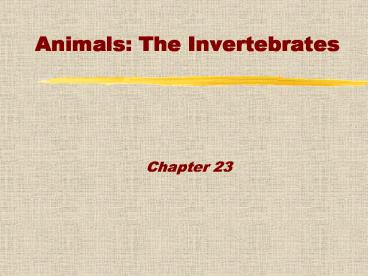Animals: The Invertebrates - PowerPoint PPT Presentation
1 / 39
Title: Animals: The Invertebrates
1
Animals The Invertebrates
- Chapter 23
2
Key Concepts
- All animals are multicelled, aerobic
heterotrophs - Animals originated about 900 million years ago
- Comparisons of body plans of existing animals
with fossil records reveal that there were
several trends in the evolutions of certain
lineages
3
Key Concepts
- Divergences gave rise to two major lineages
those of the mollusks, annelids, and arthropods
and the other one to the echinoderms and
chordates - The arthropods, especially the insects, have been
the most successful animal groups
4
Evolutionary Tree Diagram
5
Overview of the Animal Kingdom
- Animals
- Multicellular
- Heterotrophs
- Oxygen is required
- Sexual reproduction (some asexual)
- Motile - in part of life cycle
- Embryonic development
- Mitotic cell divisions in embryo
- Tissue layers
- Ectoderm, Endoderm, Mesoderm
6
Diversity in Body Plans
- Vertebrates
- Mammals birds, reptiles, amphibians,
fishes - Invertebrates
- No backbones
- Body symmetry Cephalization ( sense in the
head) - Gut
- Body cavity
- Segmentation
7
Examples of Body Symmetry
- Radial
- Live in water
- Bilateral
- Mirror image
8
Type of Body Cavity in Animals
- Gut, body cavities, segmentation
9
Type of Body Cavity in Animals
- Lined body cavity
10
SpongesSuccess in Simplicity
- No symmetry, tissues, or organs
11
SpongesSuccess in Simplicity
A basket sponge releasing a cloud of sperm
12
Tissues in a Jellyfish
The sea nettle, a jellyfish (Chrysaora)
13
Stages in Cnidarian Life Cycles
- Both polyp and medussa body forms
Physalia Portuguese Man-of-War
14
FlatwormsTurbellarians, Flukes Tapeworms
Nervous system in a Planarian
Reproductive system in a Planarian
15
Tapeworms
- Parasitic
- Scolex
- Proglottids
- Hermaphroditic
16
Roundworms
- Most abundant multicelled animal
- Bilateral symmetry
- Cylindrical body
- Cuticle
- Complete digestive system
- Male and female
17
Flukes
- Parasitic
- Sexual or asexual phases
- Two hosts
- Snail
- Human
Life Cycle of Schistosoma japonicum
18
A Sampling of Mollusks
- Mollusk
- Soft body
- Shell
- Mantle
- Fleshy foot
- Gastropods-snails
- Chitons
- Bivalves-clams
- Cephalopods-squid
19
Evolutionary Experiments with Body Plans
Radula is used to scrape food into the mouth
20
Evolutionary Experiments with Body Plans
Body Plan of a clam
21
Evolutionary Experiments with Body Plans
Body Plan of a cuttlefish, a cephalopod
22
Annelids Segments Galore
- Bilateral
- Segmented
- Earthworms
- Leeches
- Polychaetes
23
Earthworm Body Plan
Coelomic chambers
A nephridium
24
Earthworm Body Plan
Portion of the closed circulatory system
Part of the digestive system
25
Earthworm Body Plan
Part of the nervous system
26
Arthropods The Most Successful Organisms on
Earth-Arthropods
- Over one million species
- Trilobites (extinct)
- Chelicerates
- Spiders
- Crustaceans
- Barnacles and crabs
- Uniramians
- Centipedes, millipedes, insects
27
Adaptations of Insects and Other Arthropods
- Hardened exoskeleton
- Jointed appendages
- Fused and modified segments
- Respiratory structures
- Specialized Sensory Structures
- Division of labor
28
A Look at Spiders
Organization of a Spider Body
29
A Look at Crustaceans
- Shrimps, lobsters, crabs, barnacles
A Copepod
A Lobster
30
Life Cycle of a Crab
Continuous molting
31
A Look at Insect Diversity
- Head, thorax, abdomen
- Sensory antennae
- Mouthparts
- 3 pairs of legs
- 2 pairs of wings
- Malphigian tubules
- Waste disposal
- Life cycles
32
A Look at Insect Diversity Examples of Appendages
Grasshopper
Butterfly
Mosquito
Fly
33
Examples of Post-Embryonic Development
Silverfish
True bugs
Fruit flies
34
The Puzzling Echinoderms
- Echinoderms
- Sea star
- Sea urchin
- Sea cucumber
- Brittle stars
- Body walls
- Spines, spicules
- Radial symmetry
- Decentralized nervous system
- Water-vascular system
35
The Puzzling Echinoderms
Sea urchin
36
Key Aspects of the Radial Body Plan of a Sea Star
37
In Conclusion
- Animals are multicellular, aerobic heterotrophs
that ingest or parasitize other organisms - Animals range from structurally simple placozoans
and sponges to vertebrates
38
In Conclusion
- Almost all animals more complex than cnidarians
show bilateral symmetry, form tissues, organs,
and organ systems - All mollusks have a fleshy soft body, and a mantle
39
In Conclusion
- The annelids, have a segmented body, complex
organs, and coelomic chambers - Arthropods are the most successful of all groups
in terms of diversity, numbers, distribution,
defenses, and capacity to exploit food resources - Echinoderms have spines, spicules, or plates in
their body wall - developed by M. Roig































